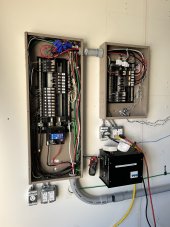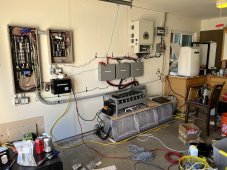Interesting reading through the comments on the LV6548 topic. I believe Will stated he thought the Sol-Ark had a ground-neutral relay, so perhaps this is a bit different than was is proposed above. Looking at Sol-Arks simplified wiring diagram, it looks like neutral/ground is connected at all points (inverter, critical loads panel, main panel, generator, etc...). My thought was just throwing in a manual transfer switch to switch the two mains coming from either main panel or inverter; ultimately, all neutral/ground wires have continuity between each device, which I don't see why a GFCI/ARCI circuit breaker wouldn't function correctly.
Hybrid inverter main panel wiring, grid through inverter only?
- Thread starter Slvrsky07
- Start date





